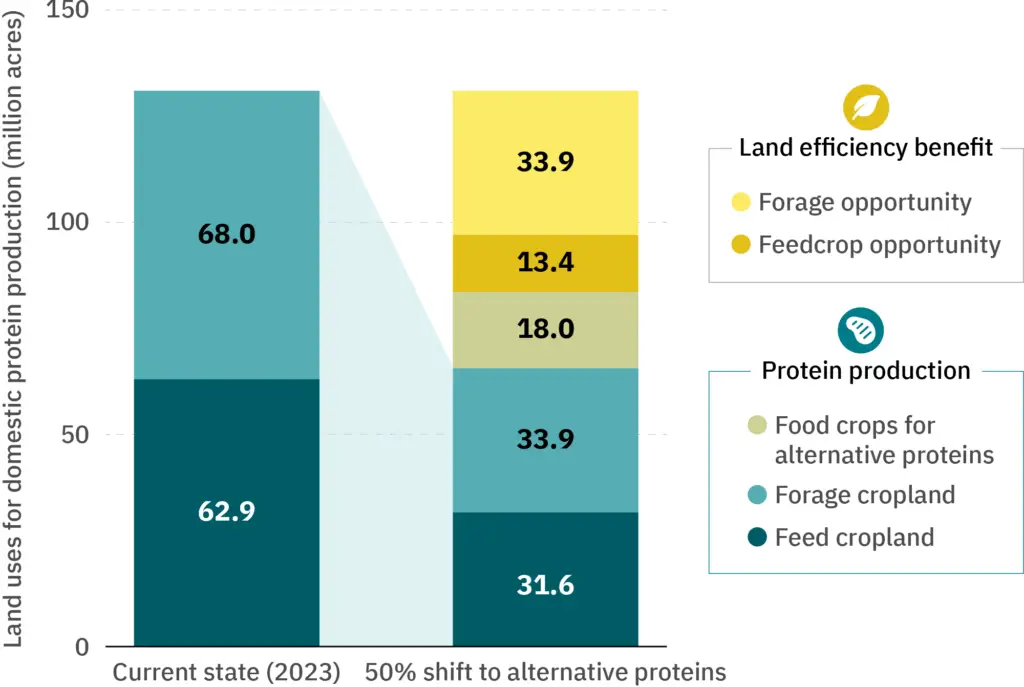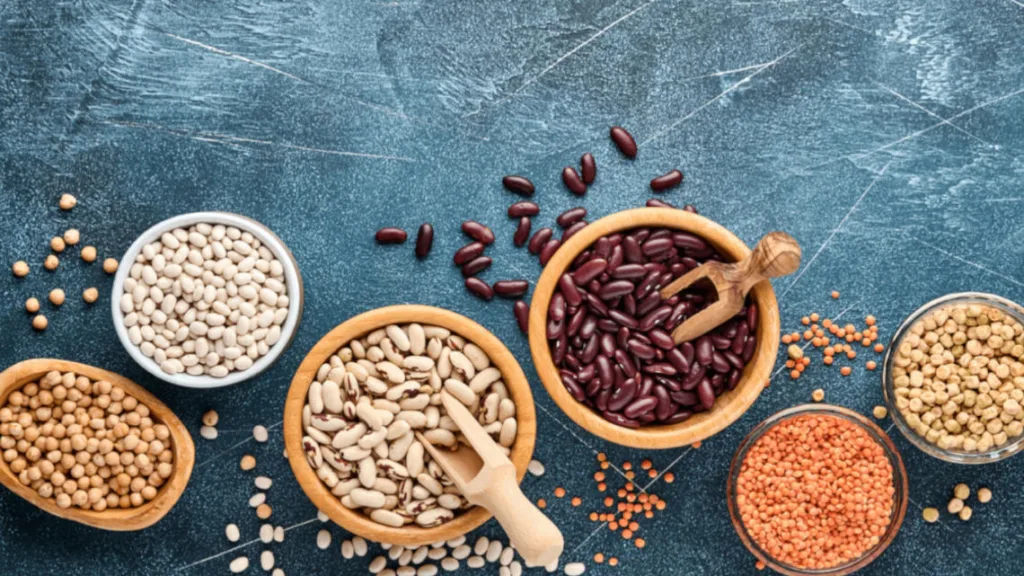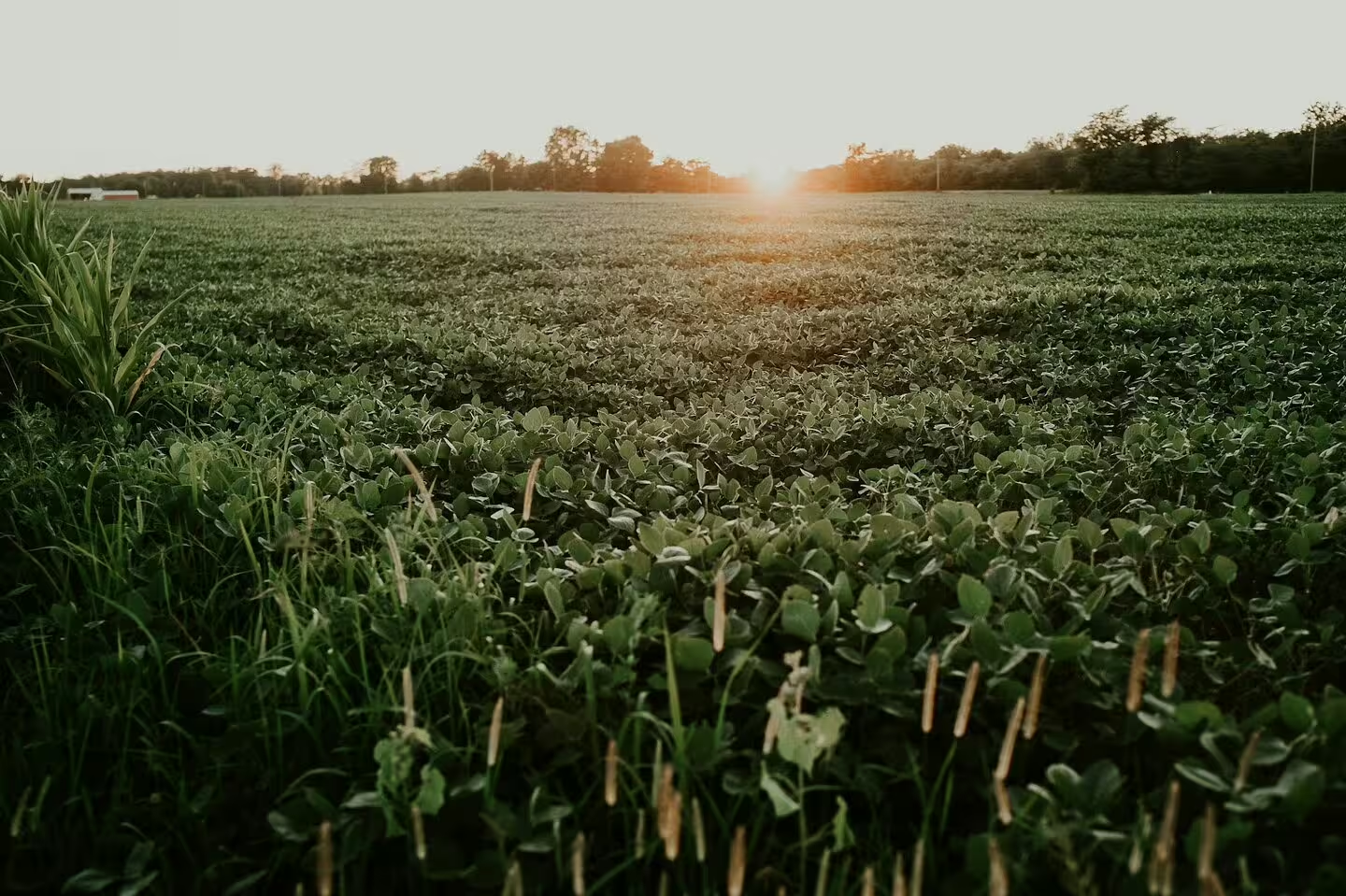Authors
Ludmila Hannah Cmarkova Intern, Agriculture and Food, WBCSD Pathways
The current global food systems are not future-proof. We are running out of room for food production, which leads to deforestation and degradation of other ecosystems. Over two-thirds of the world’s agricultural land is used for livestock production. Additionally, food and agriculture account for one-third of all greenhouse gas emissions, with animal agriculture alone accounting for 11 to 20% of all emissions. With demand for meat on the rise, we need to address how we produce and consume protein if the world is to achieve its climate and nature goals.
Shifting the protein supply from animal-based foods to land-efficient alternative proteins (i.e. meat made from plants, cultivated from animal cells or produced via fermentation) can significantly reduce the land requirements for food production and enable large-scale restoration of agricultural land. This shift offers environmental and socioeconomic benefits, including climate and biodiversity gains, reduced water use, soil preservation, and improved farmer livelihoods. Moreover, transitioning toward alternative proteins can make food systems more resilient to climate change and supply chain disruptions, further strengthening global food security.
New research demonstrates significant land conservation and restoration opportunities in the US
A new study from the Good Food Institute (GFI), a long-standing World Business Council for Sustainable Development (WBCSD) partner and alternative protein research and advocacy organization, indicates that a shift toward alternative proteins in the US protein supply would enable a significant amount of land to be repurposed for agroecological and regenerative farming and ranching as well as for habitat restoration and conservation. The report highlights alternative proteins as a powerful, scalable solution for achieving climate goals and emphasizes their significant nature benefits, especially in the American context.
The key takeaways from the report are:
- Threatened ecosystems can be restored by reimagining our food systems. Of the 485 terrestrial ecosystems in the US, 45% are currently under threat. The report reveals that a 50% shift toward alternative proteins would facilitate the restoration of cropland in approximately 138 of the 216 US ecosystems currently under threat. This represents approximately 13% of the US National Climate Task’s goal to conserve about one-third of US land and water by 2030.
- Alternative proteins create opportunities to maximize carbon sequestration through restoration of forests and lands along water bodies. Enhancing carbon sinks is essential to meet the US Nationally Determined Contribution to the Paris Agreement. A 50% shift toward alternative proteins has an annual carbon sequestration opportunity of 177.8 million metric tons (MMT) of CO₂ equivalent by improving land use efficiency and enabling restoration of croplands to forests and wetlands. This means a 22% increase in the net national carbon sink associated with all land use, a sequestration opportunity greater than the CO2 emissions of all US domestic flights per year.
- Alternative proteins can enable nature-based solutions (NbS) by improving land-use efficiency. In the US, over half of land is used for animal agriculture, most of it for animal feed and forage. Land requirements for alternative proteins are 50-90% lower than animal proteins per kg of protein. A 50% shift to alternative proteins would significantly reduce land use, requiring 47.3 million fewer acres of cropland (Figure 1). Land-efficient alternative proteins, therefore, allow more space for regenerative agriculture and other NbS.

Figure 1: Land use shift of feed crop and forage cropland and land use efficiency benefit with a 50% shift toward alternative proteins.
The impact of alternative proteins on global land use: the case of Europe and Brazil
Further evidence supports the positive impact of transitioning toward alternative proteins on global land use. The report on the opportunity of alternative proteins in Europe by Green Alliance, funded by GFI Europe, suggests the transition toward alternative proteins could greatly increase Europe’s self-sufficiency. This means that nearly every country studied could eliminate their reliance on foreign farmland and return to levels of food self-sufficiency last experienced 30 years ago. Moreover, increased uptake of alternative proteins would enable landowners to restore a third of currently farmed land into a semi-natural habitat. This would be in line with EU’s Nature Restoration Law and increase regenerative and agroecological farming and ranching by 400%.
Each year, 5 million hectares of forest are lost, 95% of which are in the tropics – mainly to grow crops or raise livestock. One-third of all deforestation occurs in Brazil, mostly due to expansion of beef pastures and soy (the vast majority of which is fed to chickens and pigs) or palm oil fields. Alternative ways of producing high-quality proteins such as novel plant-based meat or cultivated meat could be transformative. Alternative proteins allow people to continue eating products that provide the taste and texture they want, while reducing agricultural land use and nitrogen-related emissions – without contributing to the destruction of tropical forests.
The shift toward alternative proteins plays a crucial role in food and nutrition security by growing crops directly for people rather than using them to feed the animals we consume. While alternative proteins are likely to become more available and affordable in Low- and Middle-Income Countries (LMICs), the immediate focus should remain on addressing existing nutritional needs, especially in countries where meat consumption is traditionally low.
The private sector plays a crucial role
When the private sector invests in research and development to diversify product portfolios with alternative protein products, they accelerate the transition to land-efficient alternative proteins equitably in the US and globally. Moreover, companies can support consumer adoption of alternative proteins by developing viable options and positioning them to appeal to a broader audience. However, careful consideration is needed to ensure that this shift supports and benefits all stakeholders, creating new opportunities, income streams and livelihoods for existing agricultural communities.
WBCSD is actively collaborating with member companies and other ecosystem actors to support the traditional protein value chains in becoming more sustainable while facilitating the transition toward alternative proteins. WBCSD offers tools and resources to help companies to promote consumer behavior change toward plant-forward foods and provides resources like The Plant-Forward Opportunity: A Business Playbook to Meet Consumer Demand Within Planetary Boundaries to help businesses evaluate opportunities for transitioning their portfolios.
To get involved in WBCSD’s work on protein diversification, please reach out to Melanie Levine at levine@wbcsd.org. To learn more about GFI’s recent report on land use in the US context, please contact Shayna Fertig at shaynaf@gfi.org or Priera Panescu Scott, PhD at prierap@gfi.org.
Outline
Related
Content

Beans will play a key role in the transition to a healthy and sustainable food system – New campaign tells you how
1 May, 2023

Protein Impact Framework – a flexible tool for companies to assess the sustainability & health impact of animal and plant-based proteins
18 August, 2020

Fixing our food system as a cure for our planet
14 May, 2020
